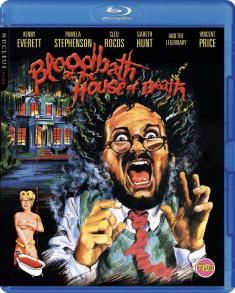Klipsch Reference Premiere HD Wireless Speakers
Overview -PROS
-Impressive tech
-Nice sound
-Compact Control Center
-2.0-7.2 configurations
-No speaker cable
-Simple to set up
CONS
-Terrible Remote
-No Atmos or DTS:X speaker support
-PCM, Dolby Digital, & DTS only
-Price
-Power Cables
-Limited Settings
INTRO
With the Reference Premiere HD Wireless system, Klipsch has elected to bring to market a new home theater segment, full-blooded wireless power. Available in 2.0 all the way up to 7.2 configurations, Reference Premiere HD Wireless is presented as having home theater worthy speakers without compromise for size or power. At the same time, the system supplants the need for an AVR, and in its place is a streamlined HD Control Center that looks small even to the compact PS4.
While the audio design of the horns, tweeters, and woofers derives from the same thinking as Klipsch's latest Reference Premiere series, the distinguishing technology for the HD Wireless comes via the WiSA compliance test specification. This standard was developed to provide uncompressed audio bandwidth on frequencies not currently in use in other wireless technology.
But while the system uses WiSA and avoids the wireless tricks of various other wireless speaker attempts (such as power routing or WiFi carrying), there must still be a power cable for each speaker. Each speaker is then a wireless monitor, but is nevertheless helpless without the HD Control Center.

REFERENCE PREMIERE HD WIRELESS
Right off the bat, it's easy to point out that the scalable Reference Premiere HD Wireless is an amazing first-generation product. Klipsch has clearly aimed to not only deliver top of the line wireless performance, but to also make setting up and having a home theater more attractive for anyone who gets squeamish over the idea of "stereo instructions" (see the film 'Beetlejuice' for further elaboration on the discouraging association that many people have for hooking up audio equipment).
But this trailblazing has some severe drawbacks. Trading a mess of speaker cable for multiple power cables isn't the most obvious innovation for many home theater enthusiasts. Likewise, those of us who are versed in connecting electronics on a rack level and in fussing with various settings are apt to lack appreciation for the ease of use put forward here.
Even with the drawbacks, this system makes for a serious home theater, and after using it for a few weeks, I'm convinced that anyone looking for a 5.1 – 7.2 configuration should consider it. But wireless must be a must.
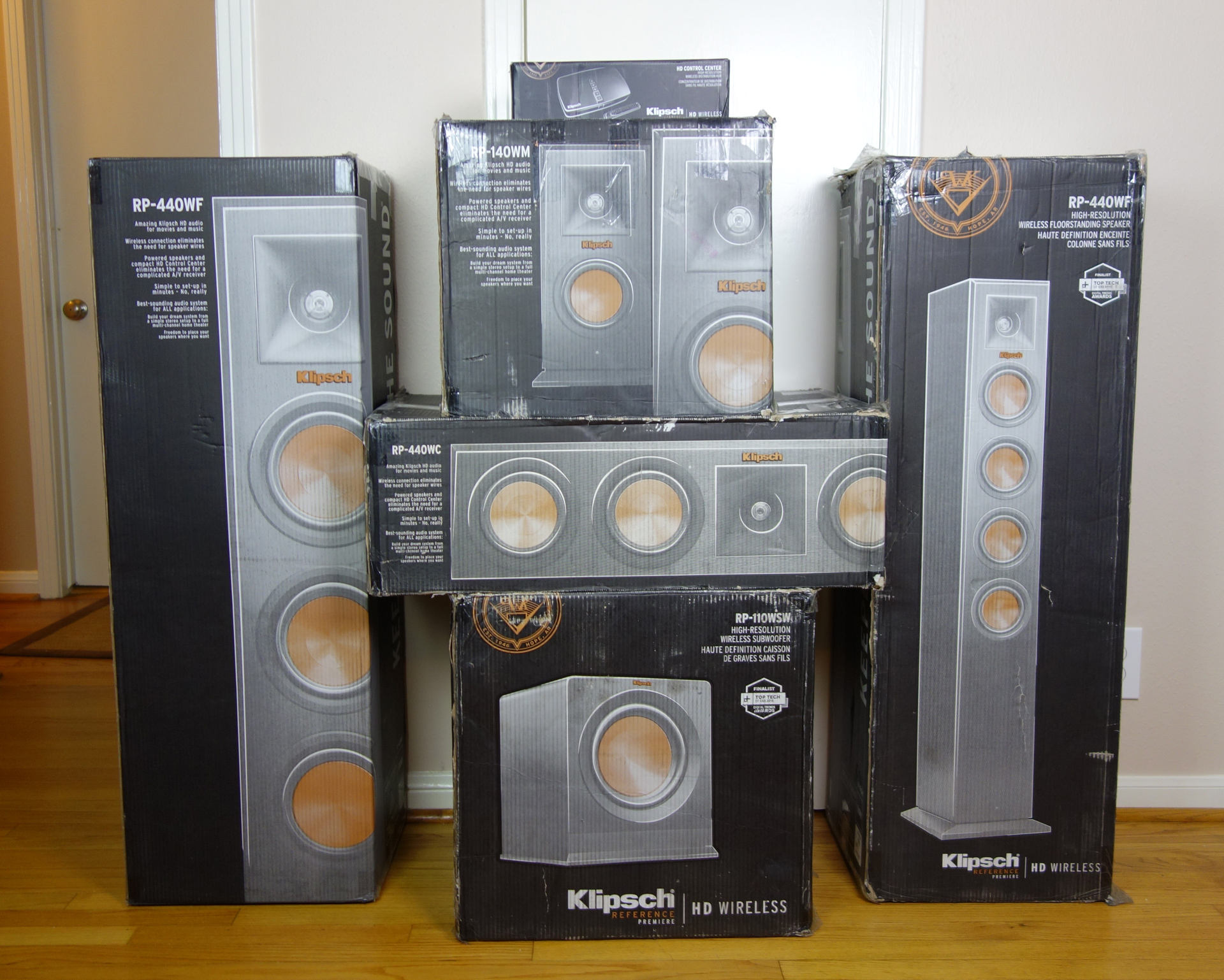
KLIPSCH LOOKS
As much as any speakers in Klipsch Reference series, the Reference Premiere HD Wireless pull off a great dual look -- understated with the speaker covers in place; attention-grabbing but stylish with the covers off. With the exception of the sub, all of the speaker covers attach via magnets, and are quick and easy to remove or don. The sub has a more conventional four post speaker cover.
One thing that is interesting about the system, much like a lamp or a fan, it's easy to move the pieces around when necessary like say when testing out different subwoofer positions. In addition to having a built-in angled base plate, the bookshelf monitors have a mounting receptacle on the back near the top.
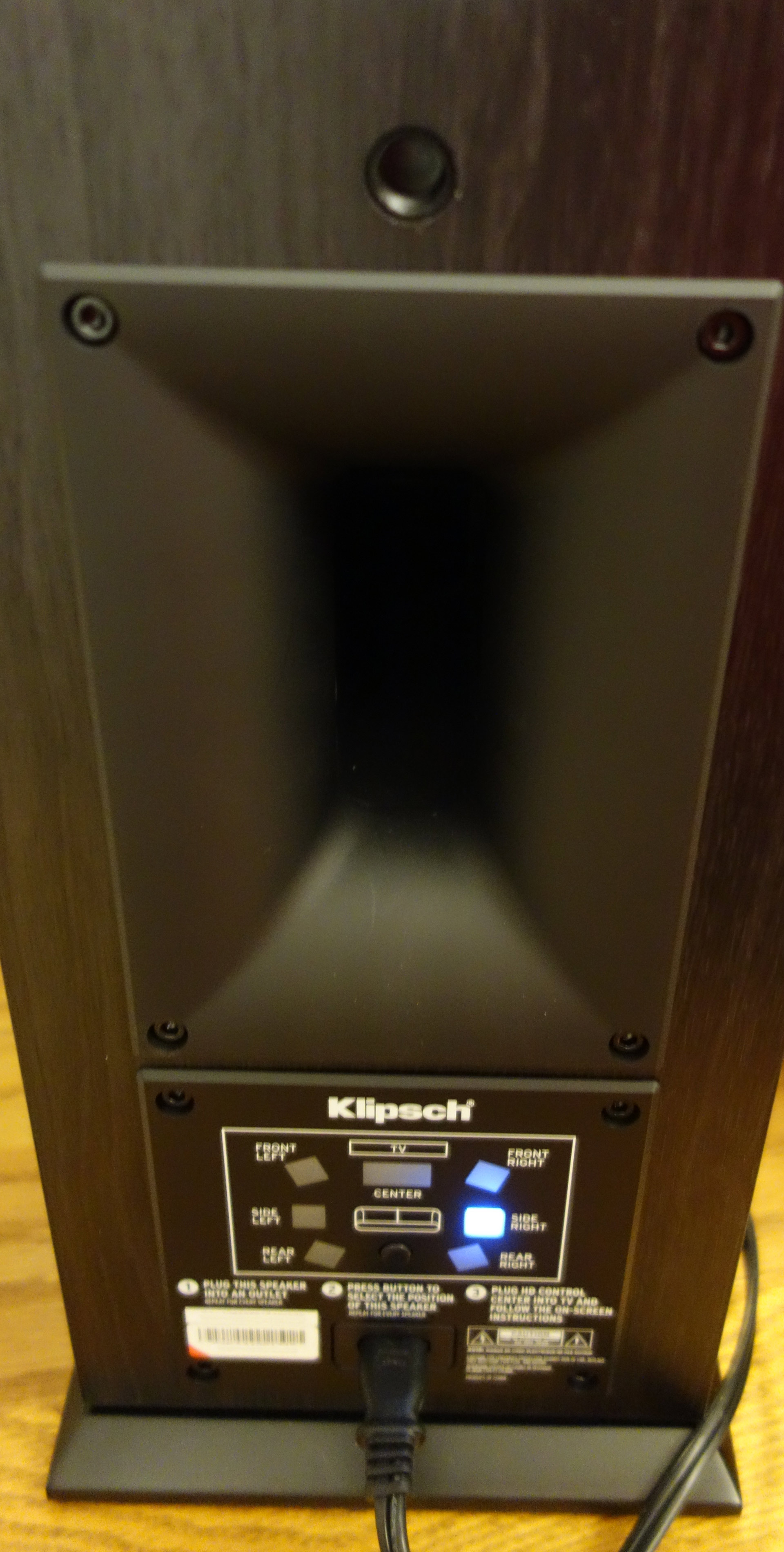
SPECIFICATIONS
To be clear this is a review of the Klipsch Reference Premiere HD Wireless 5.1 system. As reviewed the system consists of two RP-440WF tower speakers, two RP-140WM bookshelf speakers, a RP-440WC center speaker, a RP-110WSW sub, and a RP-HUB1 HD control center. As each of the seven components are powered, no other amp or AVR is required or was used in the review. The review is focused primarily on home theater applications including Blu-ray, Ultra HD Blu-ray, and streaming playback as well as games.
The HD Control Center has 4 HDMI inputs, and one HDMI output. The first HDMI input is HDCP 2.2 compatible. There are also a coaxial, optical, and RCA inputs (one of each). A Bluetooth connection is also supported as a major feature (press and hold the Bluetooth button on the remote to initiate pairing). The HD Control Center has a small external power supply not unlike most set top boxes. The final connection on the HD Control Center is a 3.5mm IR input, which is there is case the user completely wants to hide the unit.
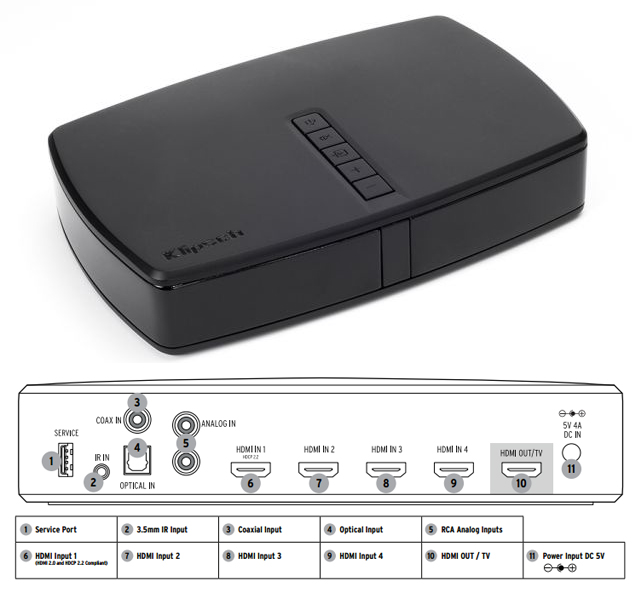
SET-UP
One of the ideas with this kind of wireless tech is to make setting up a home theater about as simple as unboxing and powering up. Unboxing the Reference Premiere HD Wireless 5.1 is about as simple as unboxing six boxes full of 170 pounds of speakers can be. The towers, sub, and bookshelf speakers have built-in angled bases, which makes the towers, for example, a little bit trickier to free from the cardboard and Styrofoam then the typical baseless cube-shape speaker enclosure, but at 36.5 lbs., each floorstanding tower is manageable and by my reckoning, living-room friendly.
Each speaker needs power, and the units come bundled with a simple two-prong power cable. At only about a meter long, there's not much slack. I had thought the rears would be close enough to power outlets prior to the unboxing, but I ended up needing a short extension for each. Once all the speakers are plugged into power, then each one can be assigned. There is a button and speaker map on the back of each speaker, and pressing the button designates where the speaker goes on the map. In my case, it's Front Left for the left tower, Front Right for the right tower, Side Right for the right rear bookshelf and Side Left for left rear bookshelf. That leaves Center for the center speaker. The sub does not need to be set.
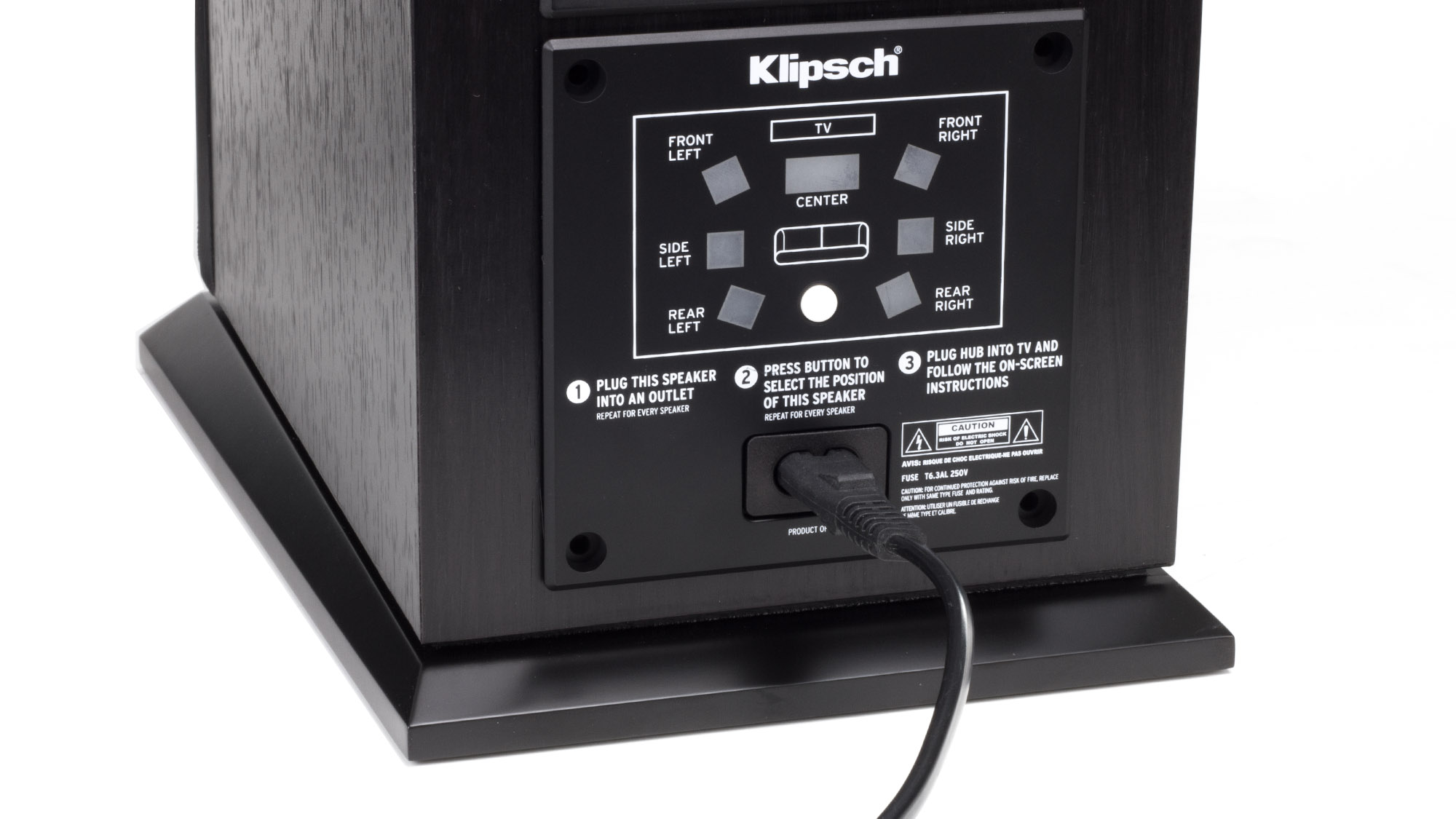
Not only is this system both easy to use and check, it's easy to add in two more speakers and a sub. (When using two subs, the sub settings are shared.) Once the speaker map is right for each speaker, the HD Control Center it ready to be powered up.
Much like a modern AVR, the HD Control Center should be hooked up to a display via HDMI before trying to complete the set-up. The on-screen menu is critical. Once the speaker designations have been verified on-screen, the set-up is for the most part complete.
Getting this far and being able to switch around the 4 HDMI inputs should mean that the user has a good 5.1 set-up in place. Anything more complex -- using the Audio Return Channel, setting speaker distance or level, using HDMI standby, or even dimming the power lights on the speakers -- requires navigating the on-screen menu. While these settings may suggest an AVR level of complexity, there's more streamlining that just the simple speaker map.
The HD Control Center knows each speaker. It knows the power and design, and thus, with the current firmware, it has the crossover for the towers and center set at 70 Hz and the bookshelf speakers at 85 Hz. It also reads all five speakers as "small." These settings normally trip up new home theater users, so having them preset to what I consider to be sensible, given the presence and capabilities of the sub, is a real advantage. That said, I can't change those settings. I can tweak the sub volume, distance and position, but not the crossover
Here again, each speaker has its own internal amp. When unboxing the system I immediately wished I could hook up the towers to one of my amps for a test drive, which is what I would do with passive speakers or with monitors (via pre-outs). But, shy of another WiSA piece, this is a comparatively closed system.
During my time with the system I tested out adding and removing speakers. While it's easy enough to just power one or multiple speakers down, this should really be done through the menu, or at least, the set-up process should be restarted so the HD Control Center knows to stop looking for the removed speakers. In any event, a speaker that is off will show no power in the light on the front and the back. A speaker that is on and connected, will have a solid light on in the front and back. A speaker that is on but not connected, will be flashing in the front but solid in the back.
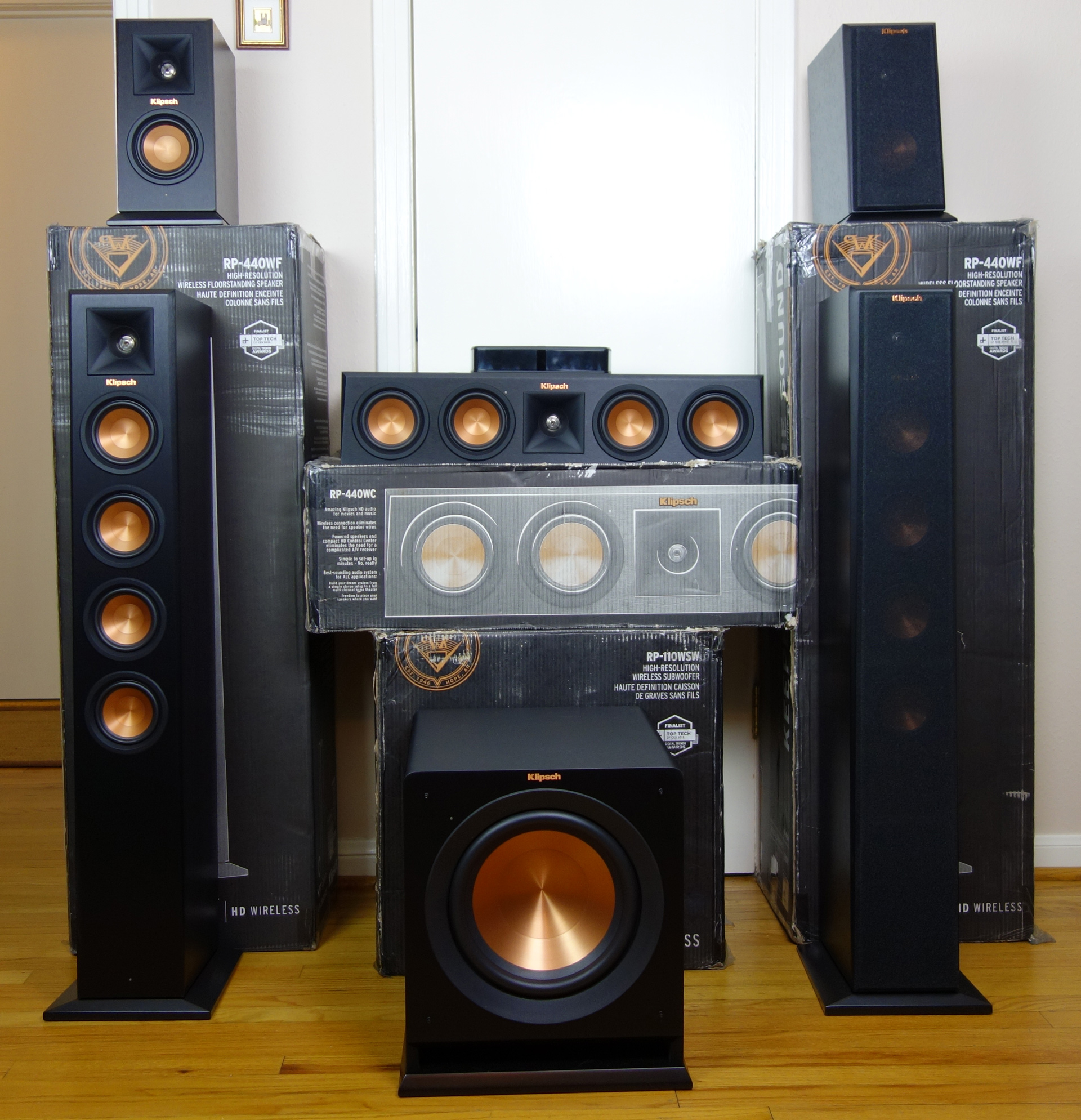
USABILITY
With the basic set-up done, the system behaved well. There were issues I'll explain below, but overall, I was impressed. Especially after the first two days, the system did its job without hiccups. It achieved the stability needed for a wireless product.
I had several issues with the system, most of which can be attributed to usability. The first two times I used the system, I had issues with speakers dropping out. I was quite concerned that the review units were faulty, but I think the issue may have had more to do with having the control center so close to a running PS4 that they nearly touched. Moving it an inch or so away, and suddenly, the system became solid. The experience did have an effect, as from then on I watched the speakers like a hawk when powering up or powering down, but they never misbehaved again. I even did some equipment shifting, but the problems stayed gone.
Then there is the start-up time. The system seems to take about twice as long as a normal AVR to begin working. (Say 5-10 seconds instead of 2-4). Unless HDMI Standby is on, this extra wait for HDMI routing is noticeable for the impatient user such as myself. Worse, the HD Control Center remote has the Power and Mute buttons immediately adjacent, so hitting Power when wanting to hit Mute means upwards of 15 seconds of punishment. The remote itself is overly cute with ultra-tiny buttons, and ultra-tiny button text. Volume and menu navigation controls are okay, but the input buttons are almost comically bad. I have small fingers, good eyes, and plays lots of video games, but it's painfully obvious that Klipsch needs to go bigger with the remote. The five buttons on the HD Control Center itself, though a good size, are similarily difficult to discern and packed too close. There are no menu buttons on the HD Control Center, so the remote is essential. Likewise, the remote is needed for Bluetooth pairing, which is fine, but wasn't so obvious to me.

If it feels like I'm letting out some frustration on the HD Control, which in terms of price is only roughly 10% off the system cost, then I've only just begun. The display on the HD Control Center is pretty sad. The best thing going for it is the volume meter which is always visible when the unit is on. (The display can be dimmed in the options.) This meter shows the volume level and will flash when muted. The rest of the display is good for lighting up various inputs when each input is in use. Trying to discern the tiny white lettering of "HDMI2" versus "HDMI3" is close to hopeless, but at least I know that the "HDMI3" light is slightly further to the right on the HD Control center. The other two lights on the display are for Dolby Digital and DTS, respectively.
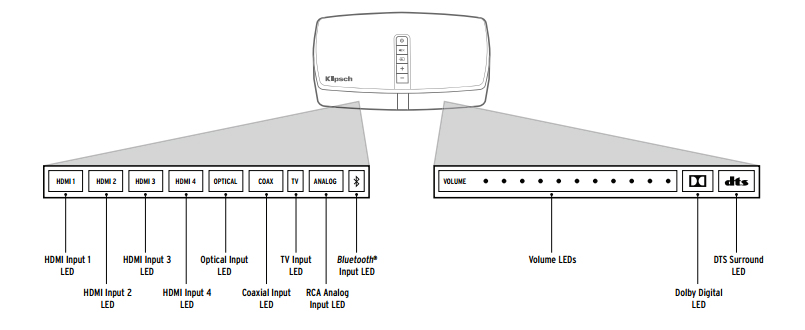
On-screen GUI fairs better. It can relay important information such as PCM 7.1, though getting such details require some trickery as the remote has no Info/Display button. "Mute" pops up on-screen when the unit is muted, though I would prefer to be able to turn off.
The unit is onscreen menu dependent, which makes sense as the optional IR sensor support clearly suggests that hiding the unit is a good idea. Unfortunately, for those of us who are 4K/UHD HDR users, this isn't such a great idea. Whether because of the built-in 4K apps on the TV or the UHD Blu-ray player, there are plenty of times when the audio system is needed (and desired) but I'm left without access to the HD Control Center's on-screen display.
For example, while the Samsung UBD-K8500 will work with the HD Control Center's lone HDCP 2.2 port for video and audio, I chose to connect the UHD Blu-ray player directly to the display for video and use the second HDMI out to connect to the HD Control Center for audio. (I did test the HDCP 2.2 on the HD Control Center a few times first just for sake of the review and was able to play UHD Blu-ray discs.) The direct connection allowed me to use the LG display's HDMI Ultra HD Deep Color setting, which didn't necessarily make sense for all of the non HDR components I had connected to the HD Color Center, such as the PS4.
I don't love having to use the ARC or HDMI-CEC, but with Smart TV apps, it's either that or optical. (ARC is unfortunately the way to go between the two.) The HD Control Center does as well with ARC and HDMI-CEC as anything else I've used. (I prefer to use the Samsung UBD-K8500's Netflix and Amazon apps over the built-in LG stuff anyway.)
Of greater concern for many users, the HD Control center can only handle PCM (up to 7.1), Dolby Digital, or DTS. That means something like Dolby TrueHD or DTS-HD must be decoded at the source and sent to the HD Control Center as LPCM. This isn't an issue for me, but could be a problem for any set-top box that aspires to Dolby TrueHD or DTS-HD, but can't internally decode it.
As reviewed, the Reference Premiere HD Wireless doesn't support Dolby Atmos or DTS:X. This may be linked to the above format limitation, but I think it goes deeper. The WiSA standard supports 8 channels, and in this system that means 7.1 (or 7.1 with the .1 doubled to 7.2). Could that change to 5.1.2 via firmware update? Maybe, but I wouldn't bet on it.
[EDITOR'S NOTE: while first gen Reference Premiere HD Wireless systems are not capable of playing back Dolby Atmos, Klipsch's Global Communications Director stated in an email to High-Def Digest, "[Dolby Atmos] is something that we are going to feature in the next generation of the speaker system. We’ll have to add elevation channels to the speakers and support more than the current eight channels." Hopefully we'll have more information about this, how it will be implimented, and whether or not it includes DTS:X, in the coming months.]
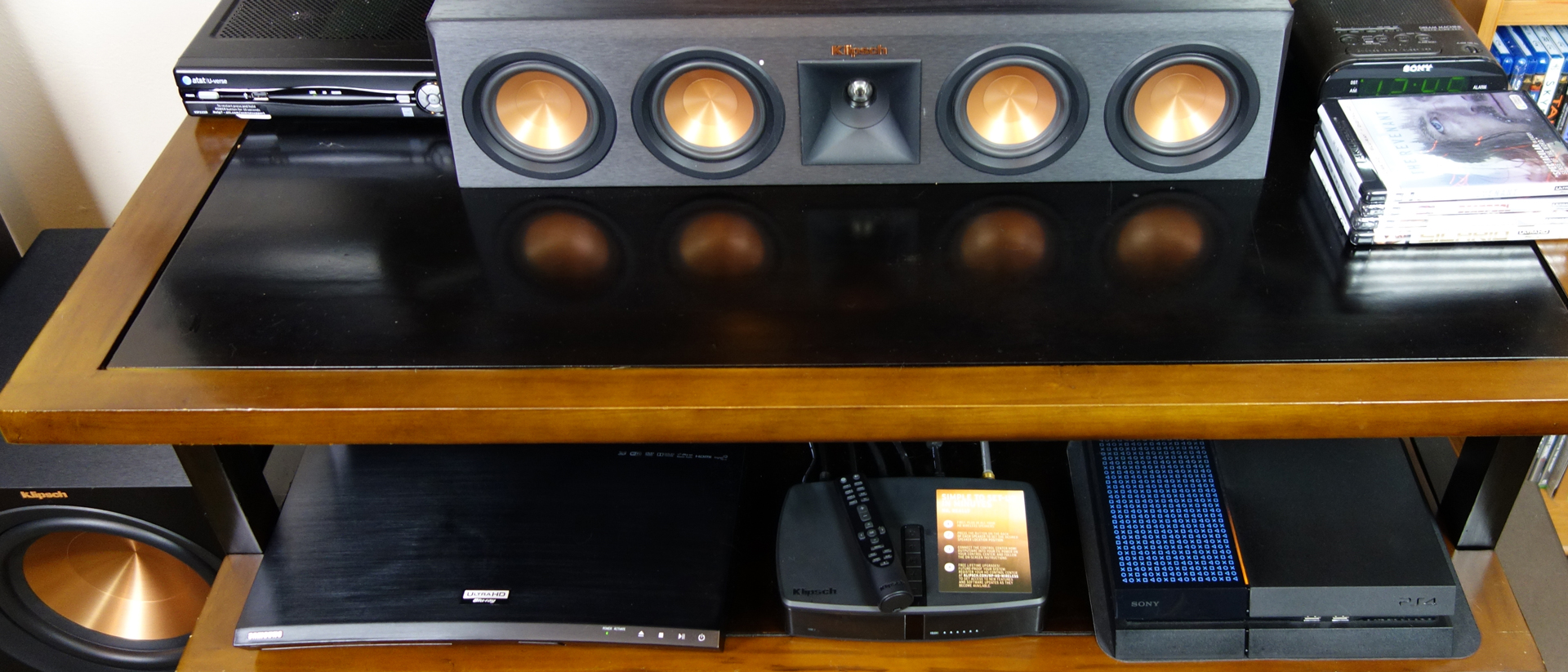
PERFORMANCE
While the Reference Premiere HD Wireless does have some obvious usability issues, audio performance, a Klipsch strength, is where the system proves its mettle. While some of the design aspects of the speakers, like the reasonable width of the towers and the height of the center, suggest a great amount of consideration for a living room setting, this is a powerful set-up, and it really demands the right source material in order strut its stuff. Sitcoms and daytime TV won't get it done. Even watching the NBA playoffs in 5.1 feels very ho-hum.
But fire something up like 'Metal Gear Solid V' on the PS4 or 'The Revenant' on Ultra HD Blu-ray and the system comes alive.
I've put well over 100 hours into 'Metal Gear Solid V' on PS4 using a variety of audio set-ups. With apologies to 'Uncharted 4' or any number of stellar FPS audio choices, 'MGS V' has the best all-around audio design right now. Pairing the game with the Reference Premiere HD Wireless, and the audio design can be experienced with true zeal. Those frequent rides to and from Mother Base in the chopper actually do have some nuance, such as in fog and rain, or when different companions share the ride. The game is full of such things, from 'The Man Who Sold the World' hospital scene to Quiet's music to Kaz and Ocelots' radio calls to the sounds of the Soviet army in Afghanistan, the audio production is top notch. One thing that really grabbed me with the Reference Premiere HD Wireless involves the famous Fulton system. That's where you attach a harness to an enemy, a prisoner, an animal, a cargo crate, a vehicle, etc. in order to extract it by air. The harness has a self-inflating balloon that pulls the object into the air where it is (off screen) picked up by the support team. I've done this countless times, and yet, I do sometimes make mistakes, like when trying to fulton an enemy that is indoors or under some kind of overhang. What happens then is that the balloon fills, but then pops. With the Reference Premiere HD Wireless, the pop of that balloon is incredibly startling. I can play the game for hours and only mess up that fulton extraction a few times, but each time with these speakers practically makes me jump at the loud pop.
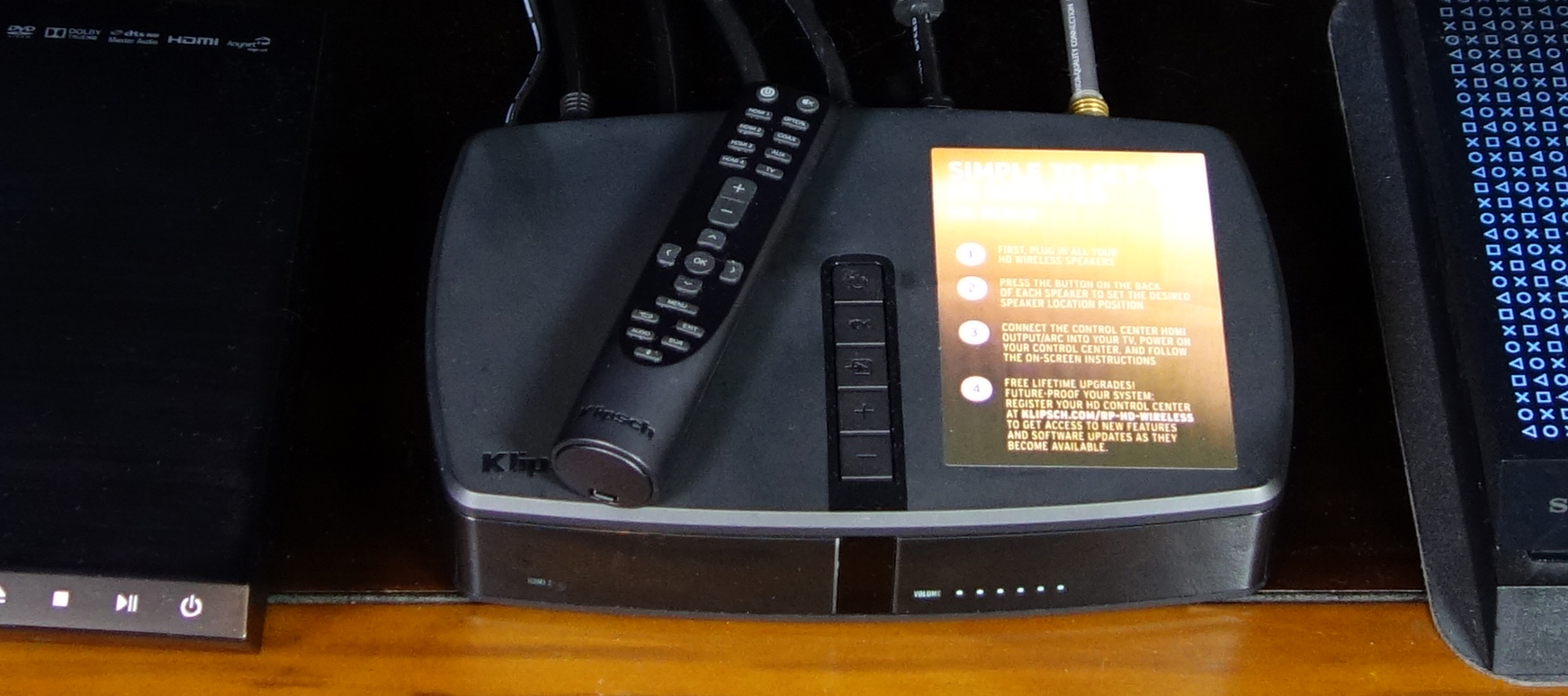
Watching UHD Blu-rays -- like the pulsating 'Sicario' -- makes it seem like the system has another gear, a top level reserved for the best stuff. In such a tense film, the soundtrack and the gunplay work together to soothe and surprise the listener. And when the dialog comes in, it's quick, but important. The Reference Premiere HD Wireless handles these expert mixes purposely and without effort. Klipsch has touted this system as being power efficient, and UHD Blu-ray playback has made a believer of me in the "Reference" label.
Early in 'The Revenant' as Glass' character is all alone in the woods, the undeniable cries of bear cubs can be heard. Even when you expect that scene, those cries come through like disquiet, suddenly close, sweet, but ominous. Almost immediately, the deep, guttural sound of the mother bear answers, and it's chilling to hear. These sounds initiate a confrontation that is as brutal and yet mesmerizing as anything in recent cinema, and this Klipsch system presents the sound without a hint of fault or misstep.
The system does have some DSP EQ options within it. An Audio Enhancement toggleable with the remote offers Natural, Dialogue, and Night Mode. There's a separate Bass Boost toggle in the menu for Low-Volume content. There is also a Surround Mode setting that can be changed directly with the remote. It cycles from Direct to Stereo, All-Channel Stereo, to a variety of Dolby PLIIX and DTS Neo:6 Cinema settings.
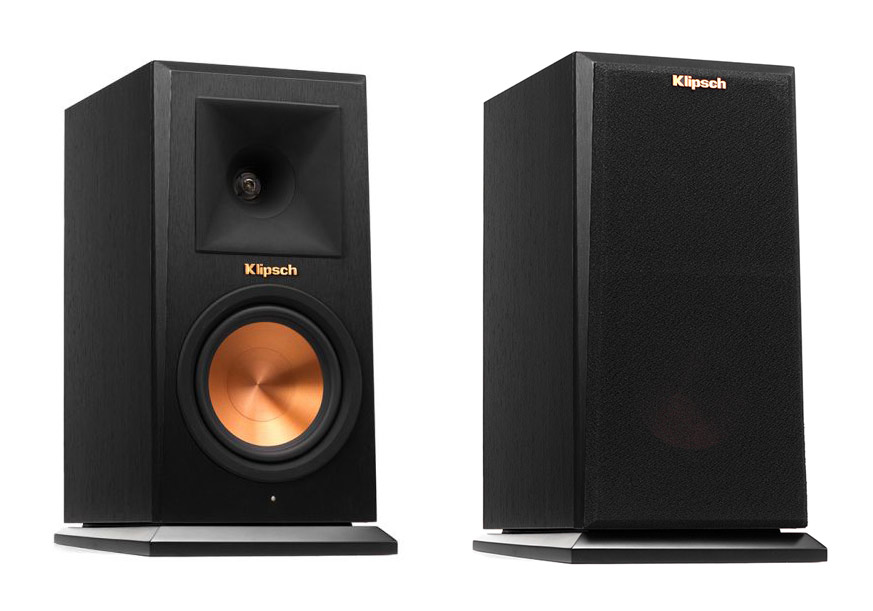
In my notes, there's no escaping that the prospective user "must want wireless. Must be willing to spend at least $5K for six channels and an ultra compact AVR. Must like the idea of plug and play." Still, I could easily see starting with just two RP-140WM bookshelf speakers in route to having four or six, but then again, the RP-440WF towers are some of the most home-friendly but still capable towers I've seen. A 7.2 outfitting with those towers at the front would be a nice match with the best content available.
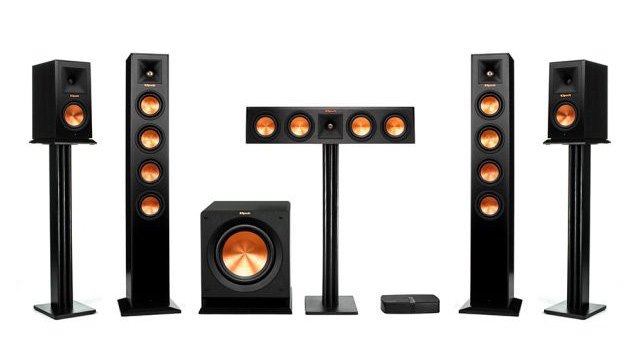
FINAL THOUGHTS
As far as wireless 5.1 home theater goes, Klipsch has a best-in-class product. (I can only presume what the 7.2 version is like.) It's simple to set up, but tougher to tweak. It's held back by a terrible remote, lack of Atmos or DTS:X support, and a gaudy price point, but the performance is grand enough to give the term "home theater" real gravitas. I suspect the wireless standard will shock even the most discerning listeners.










